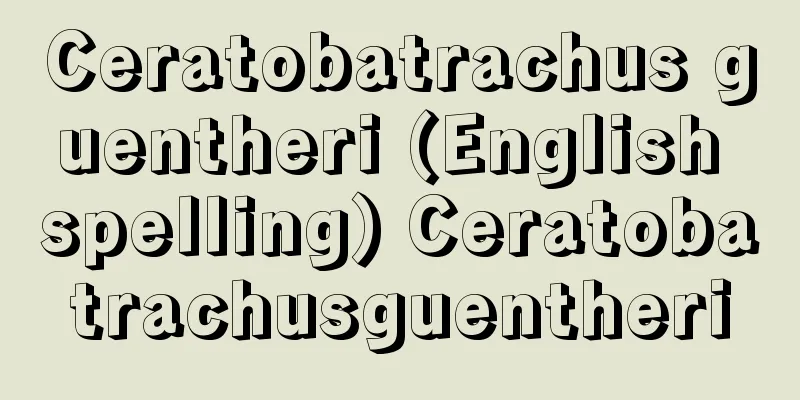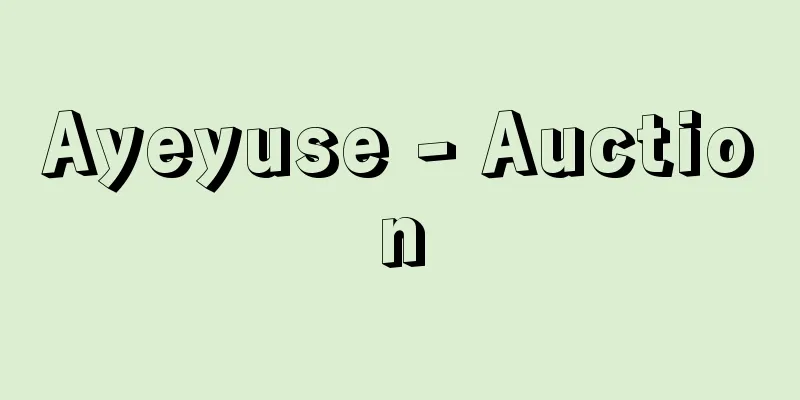Hanmotsu - Hanmotsu

〘Noun〙① During the Muromachi and Sengoku periods, a document issued by a shogun, military commander, or daimyo with a kao (signature ) or a signature and kao (signature) . It was used when issuing important political orders, such as confirmation of fiefs to samurai families, addressing them to their destination, etc. In particular, those issued by the Muromachi shogun were also called gohan gokyosho, and were considered a type of gokyosho and were highly valued. Gohan (seal) . Gohanmono. *Oyamoto Diary - March 5, 1465 (Kansho 6) "Oharano Shoji Temple Gohanmono was presented in Bishu and brought to Oyamoto ." ② During the Edo period, a document with the shogun's kao. It was more highly valued than shuinjo and kokuinjo. For example, when the shogunate granted a fief to a daimyo, a gohanmono was used if it was more than 100,000 koku, and a shuinjo was used if it was less than 100,000 koku. ※Gofukaku Kanpo Shusei, 13, September 1716 (Kyoho 1) "Those who have a Goshuin (red seal) will submit a copy of the Goshuin (red seal)." ③ During the Edo period, this refers to a meyasu (lawsuit) with the magistrate's seal on the back. The magistrate wrote on the back of the meyasu (lawsuit) submitted by the plaintiff who filed the lawsuit that the other party (defendant) should appear on a specified date, and signed and stamped it. The meyasu was delivered to the other party through the plaintiff, and the trial began. ※Chihou Rakugashi (1763), 14 "There is no difference between the Goshuin and the inscription." ④ Seal. Impression of a seal. Han. ※Kinryo Ko, Goshu, 3, Volume 27, October 1739 (Genbun 4) "Those who conspire and conspire to be convicted (omitted) The peasants joined together to write on the paper with the meyasu ( red seal) by joining the opening of the meyasu (red seal) with a blank piece of paper and writing on the paper with the meyasu (red seal)."Hanjimono [paper in writing]Hanmono [Judgment]Source: The Selected Edition of the Japanese Language Dictionary About the Selected Edition of the Japanese Language Dictionary Information |
〘名〙① 室町・戦国時代、将軍・武将または大名が花押(かおう)または自署と花押を記して出した文書。武家に対する知行の安堵(あんど)、宛行(あておこない)、その他重要な政治向きの命令を発するとき用いられた。特に、室町将軍の出したものは御判御教書とも称され、御教書の一種に数えられ重視された。御判(ごはん)。御判物。※親元日記‐寛正六年(1465)三月五日「大原野勝持寺御判物以二備州一被レ進之親元持参」② 江戸時代、将軍の花押のある文書。朱印状、黒印状より重視され、たとえば、幕府が大名に所領を与える場合、一〇万石以上のときは御判物、一〇万石以下のときは朱印状を用いた。※御触書寛保集成‐一三・享保元年(1716)九月「御判物 御朱印所持之面々は、御判物 御朱印に写を差添出之」③ 江戸時代、奉行の裏判のある目安(めやす)(訴状)のこと。訴を起こした訴訟人(原告)が提出した目安の裏に、奉行が相手方(被告)に所定の日に出頭すべき旨を記し署名捺印したもの。判物は訴訟人を通じ相手方に送達され、裁判開始の運びになった。※地方落穂集(1763)一四「御判物の儀は、墨附活等無二御座一候」④ 印。印影。はん。※禁令考‐後集・第三・巻二七・元文四年(1739)一〇月「謀書謀判致候もの〈略〉百姓連判有之口え白紙を継、判物有之紙にて書懸け」
はんじ‐もの【判物】はん‐もの【判物】出典 精選版 日本国語大辞典精選版 日本国語大辞典について 情報 |
<<: Hammock - hammock (English spelling)
>>: A bad example - Hanmenkyoushi
Recommend
Hailuoto Island (English spelling)
An island in Finland located deep in the Gulf of B...
Razor vegetable
...A biennial plant of the Asteraceae family comm...
Oxyuranus scutulatus
...The black-necked cobra N. nigricollis and the ...
Pintail duck - Pintail
A bird of the family Anatidae in the order Anseri...
About obligations - About obligations (English)
A philosophical work by the Roman philosopher Cice...
Apoda
...More than 200 species are known, including the...
Mount Mitsutoge
A mountain in the eastern part of the Misaka Mount...
Yen, J. (English spelling) YenJ
…When the People's Republic of China was esta...
Cappelletti - Cappelletti, Giovanni Vincenzo
Year of death: circa 1887 (circa 1887) Year of bir...
Banko
A supernatural dog that appears in Chinese myths ...
Active nitrogen - Catalytic nitrogen
When a discharge occurs in nitrogen gas, the nitr...
Horse keeping - Umakai no Miyatsuko
…Under the Taiho and Yoro ryo systems, there were...
Amiginu - Amiginu
One of the Jishu sect's robes, made from hemp ...
Oxyrhynchus Papyrus - Oxyrhynchus Papyrus
...However, it is not certain whether it is the s...
Schafer, RM
...The original claim of environmental music was ...









